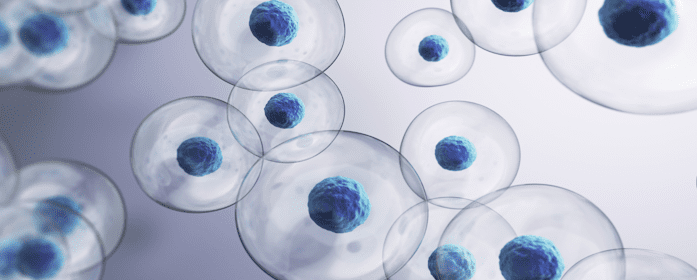
by admin | Mar 4, 2025 | Exosomes, Spinal Cord Injury, Stem Cell Research, Stem Cell Therapy
A spinal cord injury (SCI) is a serious condition that affects the central nervous system, leading to loss of movement, sensation, and bodily functions below the site of the injury. SCI is not only life-changing for those affected but also presents a significant burden on healthcare systems worldwide. Each year, thousands of people experience SCI due to accidents, falls, or medical conditions, and unfortunately, there is currently no way to fully restore lost function.
After an SCI occurs, the damage progresses in two stages: primary and secondary injury. The primary injury happens immediately upon impact, causing direct harm to the spinal cord. This is followed by secondary injury, a complex process where inflammation, cell death, and scar formation make it even more difficult for the spinal cord to heal.
In this review, Yu et al. review how exosomes are prepared, their functions, administration routes, and their role in repairing SCI, including their effectiveness alone and in combination with other treatments.
Understanding Exosomes: Functions, Benefits, and Applications
Exosomes are tiny particles that cells release into their surroundings. These microscopic vesicles, which range in size from 30 to 150 nanometers, help cells communicate by carrying proteins, genetic material, and other molecules from one cell to another. Exosomes play a key role in many biological processes, including immune responses, tissue repair, and even disease progression.
According to the authors, scientists have recently begun exploring the potential of exosomes in medicine, particularly for treating spinal cord injuries. Since exosomes are naturally produced by cells and can travel throughout the body, they have the potential to serve as powerful tools for healing damaged tissues, reducing inflammation, and encouraging nerve regeneration.
How Exosomes Can Help Repair SCI
Promoting Nerve Regeneration
One of the most notable challenges in SCI recovery is nerve regeneration. Nerve cells, or neurons, do not repair themselves easily after damage. However, research has shown that exosomes may help stimulate this process. Certain types of exosomes have been found to contain molecules that encourage nerve cell growth and survival. By delivering these molecules to injured areas, exosomes may promote the repair of damaged nerves and improve functional recovery.
Reducing Inflammation
Inflammation is a major contributor to secondary injury after SCI. When the spinal cord is damaged, immune cells rush to the site, releasing chemicals that cause swelling and further harm to nerve cells. Exosomes have been shown to help regulate the immune response by reducing inflammation and preventing excessive damage. By controlling the body’s inflammatory reaction, exosomes may create a more favorable environment for healing.
Protecting Against Cell Death
After SCI, many nerve cells die due to stress and lack of oxygen. Exosomes may offer protection by delivering molecules that help cells survive. Some exosomes have been found to block pathways that lead to cell death, allowing more neurons to stay alive and functional. This protective effect could be crucial in limiting the long-term effects of SCI.
Encouraging Blood Vessel Growth
Blood flow is essential for delivering oxygen and nutrients to the spinal cord. After an SCI, blood vessels in the area may be damaged, further reducing the chances of recovery. Exosomes have been found to support the growth of new blood vessels, improving circulation to injured areas. This process, known as angiogenesis, can help supply the spinal cord with the nutrients it needs to repair itself.
Combating Oxidative Stress
Oxidative stress is another factor that worsens spinal cord injuries. It occurs when harmful molecules called free radicals accumulate and damage cells. Exosomes contain antioxidants that can neutralize these harmful molecules, protecting nerve cells from additional damage. By reducing oxidative stress, exosomes may help preserve spinal cord function and promote healing.
Using Exosomes for SCI Treatment
Direct Injection
One way to use exosomes for SCI treatment is by injecting them directly into the injured area. This method allows exosomes to reach damaged nerve cells quickly and begin their repair work. However, one challenge with this approach is that exosomes may not stay in place long enough to have a lasting effect. Scientists are working on ways to improve the stability and effectiveness of direct injections.
Intravenous Delivery
Another method is intravenous (IV) delivery, where exosomes are injected into the bloodstream. This allows them to travel throughout the body and potentially reach the spinal cord. While IV delivery is less invasive than direct injection, some exosomes may be filtered out by organs like the liver before they reach the injury site. Researchers are exploring ways to improve targeting so that more exosomes reach the spinal cord.
Exosomes Combined with Biomaterials
Scientists are also investigating the use of biomaterials, such as hydrogels, to help exosomes stay at the injury site longer. Hydrogels are soft, water-based materials that can hold exosomes in place, slowly releasing them over time. This controlled release may enhance the effectiveness of exosome therapy and provide a more sustained healing effect.
The Future of Exosome Therapy for Spinal Cord Injury
According to Yu et al. emerging research suggests that exosomes could play a crucial role in promoting healing and improving recovery.
While there are still many questions to answer and challenges to overcome, the authors conclude the potential of exosomes in medicine is undeniable. With continued research and development, exosome therapy could one day provide a groundbreaking solution for spinal cord injury patients, helping them regain function and improve their quality of life.
Source: Yu, T., Yang, LL., Zhou, Y. et al. Exosome-mediated repair of spinal cord injury: a promising therapeutic strategy. Stem Cell Res Ther 15, 6 (2024). https://doi.org/10.1186/s13287-023-03614-y

by admin | Feb 25, 2025 | Back Pain, Exosomes, Regenerative Medicine, Stem Cell Research, Stem Cell Therapy
Low back pain is a widespread issue that affects millions of people worldwide, significantly impacting their daily lives and placing a substantial financial strain on the healthcare system. Existing treatment options for low back pain often provide only temporary relief and come with various limitations. With the increasing interest in regenerative medicine, newer treatments like orthobiologics, including extracellular vesicles or exosomes derived from mesenchymal stem cells, are being explored as potential alternatives for managing musculoskeletal conditions such as low back pain.
As part of this review, Gupta examines the outcomes of clinical studies using extracellular vesicles or exosomes for treating low back pain.
Understanding Low Back Pain
Low back pain is one of the leading causes of disability across the globe, affecting hundreds of millions of people. The condition is expected to increase in prevalence, with estimates suggesting that 843 million people will be affected by 2050. The lifetime risk of experiencing low back pain ranges between 65% and 85%, contributing to over $50 billion in healthcare costs each year.
Several factors can contribute to low back pain, including:
- Lumbar facet joint issues: These joints in the spine can degenerate due to aging, inflammation, or trauma, leading to chronic pain conditions.
- Disc herniation: This occurs when the spinal disc bulges into the spinal canal, compressing nerve roots and causing symptoms such as lumbar radiculopathy (pain radiating from the lower back to the legs).
Traditional Treatments for Low Back Pain
Common treatments for low back pain include physical therapy, chiropractic care, acupuncture, pain-relieving medications (such as narcotics and anti-inflammatory drugs), and minimally invasive procedures like nerve blocks and radiofrequency ablation. Despite their widespread use, these approaches often have limited effectiveness in providing long-term pain relief and may carry side effects. For example, steroid injections—one of the most commonly used interventions—often do not offer significant benefits compared to a placebo.
Emerging Treatments: The Role of Exosomes and Extracellular Vesicles
Recent research has focused on cellular therapies using mesenchymal stem cells (MSCs) due to their ability to regenerate damaged tissues. Extracellular vesicles (EVs), including exosomes, are small particles released by MSCs that play a key role in their therapeutic effects. These vesicles are known to:
- Reduce inflammation: EVs can decrease inflammation by promoting the healing type of immune cells (M2 macrophages).
- Promote tissue repair: They aid in the healing process and have lower risk of immune rejection than the cells themselves.
EVs may overcome some of the limitations of stem cell therapies, such as poor survival and retention at the treatment site, by delivering therapeutic molecules directly to the affected areas. This makes them a promising candidate for treating conditions like low back pain.
Review of Clinical Studies Using Exosomes for Low Back Pain
This review, Gupta looked at studies published up to March 2024 to assess the use of extracellular vesicles and exosomes in treating low back pain. Several databases were searched for relevant studies, including Scopus, PubMed, and Web of Science. The inclusion criteria focused on clinical trials that involved the use of exosomes for low back pain, while studies that did not explicitly use exosomes or were unrelated to low back pain were excluded.
Only two studies met the criteria:
- Study by Phillips et al.: This research involved administering exosomes derived from bone marrow stem cells to patients experiencing lumbar and cervical radiculopathy (nerve pain in the back and neck). The treatment was found to be safe and showed a reduction in pain and improvement in function at a one-month follow-up.
- Study by Wilson et al.: In this study, exosomes were injected into the facet joint space of patients with lumbar facet joint pain. The results indicated that the treatment was safe and led to significant improvements in pain relief and function at a three-month follow-up.
These findings align with other literature supporting the potential benefits of using stem cell-based therapies for managing low back pain. The use of exosomes may provide an effective alternative by retaining the regenerative properties of MSCs while avoiding some of the challenges associated with using live cells.
Exosomes: A Promising Treatment for Low Back Pain
Gupta’s review of current studies suggests that exosomes or extracellular vesicles could offer a safe and potentially effective treatment for low back pain. By targeting inflammation and promoting tissue healing, exosomes may provide a novel approach to managing a condition that affects millions of people. However, further high-quality research is necessary to confirm their long-term safety and effectiveness and to understand how they compare to existing treatments.
Source: Gupta A. Exosomes for the Management of Low Back Pain: A Review of Current Clinical Evidence. Cureus. 2024 Apr 3;16(4):e57539. doi: 10.7759/cureus.57539. PMID: 38707134; PMCID: PMC11068073.

by admin | Feb 20, 2025 | Adipose, Regenerative Medicine, Spinal Cord Injury, Stem Cell Research, Stem Cell Therapy
Spinal cord injuries (SCI) are life-altering conditions with limited treatment options. While rehabilitation and medical management can provide some improvements, regenerative medicine is emerging as a promising alternative. The CELLTOP study, an on-going multidisciplinary phase 1 study conducted at the Mayo Clinic, is investigating the safety and efficacy of adipose tissue–derived mesenchymal stem cells (AD-MSCs) to aid in spinal cord recovery.
In this initial report, Bydon et al. describe the outcome of the study’s first treated patient – a 53-year-old survivor of a surfing accident who sustained a high cervical American Spinal Injury Association Impairment Scale grade A SCI with subsequent neurologic improvement that plateaued within 6 months following injury.
The CELLTOP Trial Stem Cell Treatment Process
Nine months after his injury, the patient enrolled in the CELLTOP study. An abdominal fat tissue sample was collected, and stem cells were isolated, expanded, and preserved. Eleven months after the injury, the patient received an injection of 100 million AD-MSCs through a lumbar puncture at the L3-4 level.
Safety and Tolerability: Minimal Side Effects Observed in Trial
According to the authors, the procedure was well tolerated. The only reported side effect was a mild to moderate headache on the second day, which resolved with over-the-counter medication. No severe adverse effects were observed during the 18-month follow-up.
Observed Neurological Improvements
Following the stem cell injection, the patient showed notable improvements in motor and sensory function over 18 months, including:
- Motor Function: The patient’s upper limb motor scores improved from 35 at baseline to 44 at 18 months. Lower limb motor scores increased from 36 to 49. These improvements were observed in both sides of the body.
- Sensory Function: Sensation, measured through pinprick and light touch scores, nearly doubled. The pinprick score increased from 45 to 95, and the light touch score improved from 54 to 96.
- Upper Extremity Capabilities: The patient’s ability to use his arms and hands improved significantly, particularly in tasks requiring pulling, pushing, and finger dexterity.
- Quality of Life: The patient’s physical and mental health scores improved, as measured by the Patient-Reported Outcomes Measurement Information System (PROMIS) questionnaire.
Observed Improvements in Physical Therapy Performance
Over the 18-month follow-up, the patient also demonstrated significant progress in mobility and strength, including:
- His walking speed improved from 0.17 m/s to 0.43 m/s.
- Walking distance increased from 635 feet in 12.8 minutes to 2200 feet in 34 minutes.
- Shoulder flexibility improved, with greater range of motion in both arms.
- Grip strength and hand dexterity showed notable gains.
How Stem Cells Aid in Spinal Cord Repair
SCI leads to significant nerve damage and scarring that inhibit natural healing. Stem cells offer potential benefits by:
- Reducing Inflammation: AD-MSCs have anti-inflammatory properties that may create a more favorable environment for nerve regeneration.
- Promoting Tissue Repair: These cells can support the growth of new nerve cells and blood vessels, enhancing recovery.
- Enhancing Neuroprotection: Stem cells may help preserve existing nerve function and prevent further deterioration.
Future Prospects of Regenerative Medicine for SCI
While this case study presents promising results, further research is necessary. The CELLTOP study continues to evaluate the effectiveness of stem cell therapy in more patients. Future related studies will explore optimal dosing, timing, and potential combination therapies to enhance recovery further.
Based on these initial results, the authors conclude that regenerative medicine -particularly stem cell therapy – holds significant promise for treating SCI. The first patient in the CELLTOP study demonstrated meaningful neurological improvements, suggesting that AD-MSC therapy could offer new hope for those with SCI. Continued research and clinical trials will determine whether this treatment can become a standard option for spinal cord injury recovery.
Source: Bydon M, Dietz AB, Goncalves S, Moinuddin FM, Alvi MA, Goyal A, Yolcu Y, Hunt CL, Garlanger KL, Del Fabro AS, Reeves RK, Terzic A, Windebank AJ, Qu W. CELLTOP Clinical Trial: First Report From a Phase 1 Trial of Autologous Adipose Tissue-Derived Mesenchymal Stem Cells in the Treatment of Paralysis Due to Traumatic Spinal Cord Injury. Mayo Clin Proc. 2020 Feb;95(2):406-414. doi: 10.1016/j.mayocp.2019.10.008. Epub 2019 Nov 27. PMID: 31785831.

by admin | Feb 13, 2025 | Mesenchymal Stem Cells, Regenerative Medicine, Stem Cell Research, Stem Cell Therapy
Alcoholic liver disease (ALD) is a serious global health problem that arises from chronic or binge alcohol consumption. As a chronic liver disease, ALD occurs due to alcohol’s harmful effects on the liver, which is the first organ to metabolize alcohol. This process leads to the production of harmful byproducts that damage liver cells and cause oxidative stress. Over time, this damage triggers inflammation and fibrosis (scarring of the liver), eventually progressing to conditions such as steatosis (fatty liver), steatohepatitis (inflammation and fat accumulation), cirrhosis, and even hepatocellular carcinoma (HCC), a type of liver cancer.
Despite the growing need for effective treatment options, there are currently no FDA-approved therapies specifically for ALD. The only definitive treatments available are alcohol abstinence and liver transplantation, but these options are not always accessible or feasible for all patients. Given the limitations of current treatment options, there is a pressing need for new therapeutic strategies to combat ALD.
Challenges in Current Treatment Approaches
To date, the treatments for ALD primarily focus on managing the symptoms and delaying disease progression until a liver transplant is possible. These supportive therapies aim to reduce oxidative stress, regenerate liver cells, and control inflammation. However, they are not effective for many patients.
Various drugs have been investigated to target the underlying causes of ALD, such as oxidative stress and inflammation. Despite showing promise in preclinical studies, many of these therapies have failed to demonstrate significant benefits in clinical trials. The complexity of ALD and the fact that it often develops alongside other health issues, such as poor nutrition or hepatitis, make it difficult to find a one-size-fits-all solution.
Stem Cell Therapy: A Promising Option
In recent years, stem cell therapy has emerged as a potential treatment for ALD. Among the different types of stem cells, mesenchymal stem cells (MSCs) have shown the most promise due to their ability to regenerate damaged tissue and modulate immune responses. MSCs can be sourced from various tissues such as bone marrow, adipose tissue, and umbilical cord blood. Importantly, the use of MSCs is free from the ethical concerns associated with embryonic stem cells, making them a more attractive option for therapeutic research.
MSCs have been widely studied in the context of liver diseases, including ALD, and have shown positive results in preclinical and clinical trials. These stem cells work by reducing inflammation, promoting liver cell regeneration, and improving overall liver function. Moreover, MSCs secrete factors that contribute to their therapeutic effects. These factors, known as the secretome, contain cytokines, growth factors, and extracellular vesicles (EVs), which can mimic the healing properties of MSCs themselves.
Potential for Cell-Free Therapies
Given the challenges with direct stem cell transplantation, researchers are exploring cell-free approaches, which use the secretome and EVs derived from MSCs. These cell-free therapies could offer many of the same benefits as stem cell therapy without the risks associated with cell transplantation. For instance, the secretome contains anti-inflammatory molecules and other agents that can help regenerate damaged liver tissue, while EVs carry proteins and genetic material that help reduce liver damage.
Several preclinical studies have shown that MSC-derived secretomes and EVs can alleviate the symptoms of liver diseases similar to ALD by reducing oxidative stress and inflammation. However, more research is needed to determine the optimal methods for isolating and administering these factors in a clinical setting. One of the key obstacles is the difficulty in distinguishing between EVs and other natural components in the body, making it challenging to ensure that the right therapeutic agents are delivered to patients.
Current Research and Future Directions
Although MSC-based therapies are still in the early stages of development for ALD, the research to date has been encouraging. Studies in animal models have demonstrated that MSCs and their secreted factors can reduce inflammation, prevent fibrosis, and promote liver regeneration. For example, transplantation of MSCs has been shown to improve liver function in mice with alcohol-induced liver damage, while MSC-derived EVs have been found to enhance liver regeneration by promoting the growth of new liver cells.
Stem Cell Therapy: A Promising Future for Alcoholic Liver Disease
Alcoholic liver disease is a major global health issue, with alcohol consumption contributing to a range of liver disorders that can lead to severe and life-threatening conditions. While current treatment options are limited, advances in stem cell therapy, particularly the use of mesenchymal stem cells, offer new hope for treating ALD. MSCs and their secreted factors have shown potential to reduce liver damage, promote regeneration, and modulate the immune system, making them a promising therapeutic option for ALD.
However, despite the progress in preclinical studies, Han et al. highlight many challenges to overcome before these therapies can be widely adopted in clinical practice. Further research is needed to better understand how MSCs and their secretome work, and to develop safer, more effective treatments for ALD. In the meantime, addressing the root causes of ALD, such as excessive alcohol consumption, remains crucial to reducing the burden of this disease worldwide. With continued research and innovation, MSC-based therapies may one day offer a viable solution for patients suffering from this debilitating condition.
Source: Han J, Lee C, Hur J, Jung Y. Current Therapeutic Options and Potential of Mesenchymal Stem Cell Therapy for Alcoholic Liver Disease. Cells. 2023; 12(1):22. https://doi.org/10.3390/cells12010022

by admin | Feb 11, 2025 | Adipose, Multiple Sclerosis, Stem Cell Research, Stem Cell Therapy
Multiple sclerosis (MS) is a chronic disease that affects the central nervous system, leading to a range of physical and cognitive impairments. There are different types of MS, with the most common being relapsing-remitting MS (RRMS) and secondary progressive MS (SPMS). RRMS is primarily an inflammatory condition, while SPMS involves a progressive decline due to neurodegeneration.
While significant advancements have been made in treating RRMS with new medications that target inflammation, treatment options for SPMS remain limited.
In this study, Fernández et al. aimed to evaluate the safety and feasibility of using adipose-derived mesenchymal stem cells (AdMSCs) in patients with SPMS.
Investigating Stem Cell Therapy for SPMS
Currently, the only approved treatments for SPMS with disease activity are interferon β and mitoxantrone, but their effectiveness is either uncertain or associated with serious side effects. Ocrelizumab has recently been approved for treating PPMS, but effective treatments for SPMS are still lacking.
Recently, stem cells have shown promise in various medical applications, particularly in regenerating damaged tissues and modulating the immune system. Currently, stem cell treatments are approved for conditions like blood disorders and severe burns, but mesenchymal stem cells (MSCs) are still being investigated for other uses.
Fernandez et al.’s study was conducted in two hospitals in Spain and involved a placebo-controlled, randomized trial. Patients were divided into three groups: one receiving a placebo, another receiving a lower dose of stem cells, and the third receiving a higher dose. To ensure unbiased results, the study was triple-blinded, meaning neither the patients, treating physicians, nor the statisticians analyzing the data knew which treatment each patient received.
The study also required participants to provide 30 grams of adipose tissue for stem cell preparation. Once enrolled, patients received their assigned treatment and were monitored for a year with follow-up visits at 30 days, six months, and twelve months after treatment.
Study Results and Safety Evaluation
A total of 34 patients were initially enrolled in the study. However, four patients were excluded before receiving the treatment due to abnormalities in their stem cell samples. The remaining 30 patients completed the study, with 29 undergoing at least one follow-up assessment. Unfortunately, two patients in the placebo group passed away during the trial—neither death was linked to the stem cell treatment.
Throughout the study, 70 adverse events were reported among 22 patients, with the most common being urinary infections, respiratory infections, and anemia. Four serious adverse events occurred, but only one (a urinary infection) was in a patient who received stem cells.
Overall, the authors report that there were no major safety concerns related to the treatment.
Evaluating the Effectiveness of Stem Cell Therapy
To determine whether stem cell therapy had any effect on disease progression, the authors also analyzed various clinical measures, including the Expanded Disability Status Scale (EDSS), MRI scans, and evoked potentials (tests measuring nerve function).
At the end of the 12-month follow-up, no significant differences were found between the placebo and treatment groups in terms of disability progression. The EDSS scores remained relatively stable in all groups, and MRI scans showed no significant reduction in active lesions or brain volume loss compared to placebo.
Fernández et al. report some positive trends in nerve function tests, particularly in visual evoked potentials, which measure the brain’s response to visual stimuli. Some patients in the treatment groups showed improvements in the speed of their nerve signals, suggesting possible stabilization or mild improvement. However, these changes were not statistically significant when compared to the placebo group.
AdMSC Therapy in SPMS: Findings, Challenges, and Future Directions
This study provides valuable insights into the safety of using AdMSCs in SPMS patients. The treatment was well tolerated, with no major safety concerns.
While there were some encouraging trends in nerve function, Fernández et al. call for larger and longer-term studies to determine whether these changes translate into meaningful clinical benefits. Considering this, the authors call for future research focusing on optimizing stem cell delivery methods, exploring combination therapies, and identifying patient subgroups that may benefit the most from stem cell treatments.
Source: Fernández O, Izquierdo G, Fernández V, Leyva L, Reyes V, Guerrero M, et al. (2018) Adipose-derived mesenchymal stem cells (AdMSC) for the treatment of secondary-progressive multiple sclerosis: A triple blinded, placebo controlled, randomized phase I/II safety and feasibility study. PLoS ONE 13(5): e0195891. https://doi.org/10.1371/journal.pone.0195891

by admin | Feb 7, 2025 | Mesenchymal Stem Cells, Multiple Sclerosis, Stem Cell Research, Stem Cell Therapy
Progressive multiple sclerosis (PMS) is a complex, disabling form of multiple sclerosis characterized by the progressive accumulation of central nervous system (CNS) damage. This damage arises from chronic inflammation, demyelination, axonal injury, neuronal degeneration, and gliosis, affecting both white and gray matter in the brain and spinal cord. Despite advancements in MS research, effective reparative therapies for reversing the functional impairments associated with PMS remain largely unavailable.
A promising new approach for PMS treatment is NurOwn, a therapy based on mesenchymal stem cell-derived neurotrophic factor (MSC-NTF) cells. NurOwn utilizes a proprietary method to isolate and culture autologous (self-derived) mesenchymal stem cells (MSCs) from bone marrow. These MSCs are then differentiated to secrete high levels of neurotrophic factors (NTFs), which are believed to have both neuroprotective and immunomodulatory properties. Preclinical studies and early clinical trials have suggested that MSC-NTF therapy could help reduce CNS inflammation and promote neuronal repair mechanisms in PMS patients.
Cohen et al.’s open-label phase II study was conducted to evaluate safety/efficacy of three intrathecal cell treatments
Safety and Tolerability of MSC-NTF Therapy
In this Phase II clinical trial (BCT-101), the safety of MSC-NTF therapy was evaluated in 20 participants with PMS, of whom 18 received treatment. While most participants tolerated the therapy well, two discontinued due to adverse events related to the procedure, including mild symptoms such as coldness, muscle weakness, and fever, as well as one case of arachnoiditis -a rare inflammation of the arachnoid membrane surrounding the spinal cord.
For both affected individuals, MRI scans revealed characteristic lumbar nerve root clumping. Treatment with epidural cortisone and analgesics provided symptom relief, with one participant’s symptoms resolving fully. Importantly, there were no recorded deaths or adverse events associated with MS relapses, and no clinically significant alterations were observed in blood, urinalysis, or vital sign parameters after dosing.
According to the authors, these results highlight the potential tolerability of MSC-NTF therapy, though further studies are required to assess long-term safety.
Potential of MSC-NTF Therapy for PMS
NurOwn’s MSC-NTF cells have been tested in animal models relevant to PMS, including studies on autoimmune encephalomyelitis and optic nerve damage, which have shown the therapy’s potential to reduce inflammation and support neuroprotective mechanisms.
Current studies suggest that intrathecal (spinal) administration may offer unique benefits over intravenous administration by directly addressing meningeal inflammation and delivering neurotrophic factors close to the site of CNS damage. The capability of MSC-NTF cells to modulate inflammation and potentially promote endogenous repair makes it a promising therapeutic modality in PMS.
Functional and Biomarker Outcomes
Cohen et al.’s phase II study used several functional outcomes to assess MSC-NTF efficacy in PMS, including the timed 25-foot walk test (T25FW), nine-hole peg test (9-HPT), low-contrast letter acuity (LCLA), and symbol digit modalities test (SDMT).
Results indicated positive trends in these measures, suggesting that MSC-NTF therapy could improve mobility, hand function, and cognitive speed in PMS patients. Additionally, patient-reported outcomes, such as the MS Walking Scale-12 (MSWS-12), demonstrated improvements in walking function.
Biomarker analysis revealed reductions in cerebrospinal fluid (CSF) inflammatory markers, including MCP-1, sCD27, SDF-1, and osteopontin, indicating a decrease in CNS inflammation. Neuroprotective biomarkers, such as VEGF-A, HGF, NCAM1, and LIF, also showed consistent increases, suggesting that MSC-NTF cells might help support neuronal health and function in PMS. However, changes in neurodegenerative biomarkers, such as neurofilament light chain (NfL), were inconsistent, indicating the need for additional research to understand MSC-NTF’s impact on neuronal damage markers.
Insights and Future Directions Of MSC-NTF Therapy for PMS
This open-label, single-arm Phase II study demonstrated that MSC-NTF cells could be safely administered in participants with stable, non-relapsing PMS. Although two participants experienced arachnoiditis following intrathecal treatment, the majority tolerated the therapy well. Functional outcomes showed encouraging trends, suggesting possible benefits of MSC-NTF therapy in improving physical and cognitive function in PMS patients.
The study also highlighted several limitations, including the lack of a placebo-controlled group, which may introduce bias in interpreting efficacy results, and limitations in biomarker analysis due to sample timing. Additionally, inconsistent changes in neurodegenerative biomarkers and the small sample size warrant further investigation.
In summary, this Phase II trial provides preliminary evidence supporting the safety and potential therapeutic benefits of MSC-NTF cell therapy in PMS. While these initial findings are promising, larger placebo-controlled studies are needed to confirm efficacy and further elucidate the role of MSC-NTF cells in modulating CNS inflammation and promoting neuroprotection in PMS.
Source: Cohen JA, Lublin FD, Lock C, et al. Evaluation of neurotrophic factor secreting mesenchymal stem cells in progressive multiple sclerosis. Multiple Sclerosis Journal. 2023;29(1):92-106. doi:10.1177/13524585221122156







 St. Petersburg, Florida
St. Petersburg, Florida
